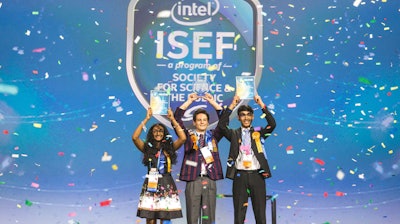
Oliver Nicholls, 19, of Sydney, Australia, was awarded first place for designing and building a prototype of an autonomous robotic window cleaner for commercial buildings at this year’s Intel International Science and Engineering Fair, a program of Society for Science & the Public and the world’s largest international pre-college science competition. The competition featured nearly 1,800 young scientists selected from 420 affiliate fairs in 81 countries, regions and territories.
In essence, a flying drone-like device is tethered to the roof of a building and equipped with a powerful spray nozzle and rotating scrubbers. The $2,300 device can withstand 28 mph winds and could replace traditional methods that can exceed $11,000 per cleaning and reduce injuries in this high-risk occupation. Nicholls received the Gordon E. Moore Award of $75,000, named in honor of the Intel co-founder and fellow scientist.
Meghana Bollimpalli, 17, of Little Rock, Arkansas, received one of two Intel Foundation Young Scientist Awards of $50,000 for her novel, low-cost approach for synthesizing materials that could greatly cut the production and energy costs of making electrodes for devices like supercapacitors. She found that combining common substances like tea and molasses with nitrogen and phosphorus in a commercial microwave formed a powder that could be used as a coating for electrode-like materials giving them similar properties of more expensive metals like platinum.
Dhruvik Parikh, 18, of Bothell, Washington, received the other Intel Foundation Young Scientist Award of $50,000 for his development of less expensive yet more robust ion exchange membranes for use in large industrial-scale batteries for storing solar or wind-generated electricity for later distribution. His composite membrane has 10 times the proton conductivity of the industry’s standard membrane while reducing production costs by about 30 percent.
“Intel congratulates Oliver Nicholls, Meghana Bollimpalli, Dhruvik Parikh and all of the participants on their groundbreaking research that will help solve some of today’s greatest global challenges,” said Rosalind Hudnell, Intel vice president of Corporate Affairs and president of the Intel Foundation. “When students from different backgrounds, perspectives and geographies come together and share their ideas, there is no limit to what they can achieve.”
In addition to the top winners, approximately 600 finalists received awards and prizes for their innovative research, including 24 “Best of Category” winners, who each received a $5,000 prize in addition to their $3,000 first place award. The Intel Foundation also awarded a $1,000 grant to each winner’s school and to the affiliated fair they represent.






















